The gold price has been going strong over the long term, up 7.7% to $1,241 so far in 2017. But if you just look at its short-term price action, you'd be hard-pressed to find many bulls.
It's frustrating to watch gold prices and feel like they're not making any headway. And that's especially true in the current context of a weakening U.S. dollar, which normally helps boost the metal...
While the dollar has fallen from 97.30 to 95.76 this week, the price of gold is also on track for a 1.2% weekly loss.
Yet if you look at gold's price behavior from a technical perspective, there's evidence that it's actually holding up exceedingly well.
After nearing the $1,300 level on June 6 for the second time this year, gold has retreated once again. But it's quite possible we've now seen a new interim low as the metal gears up to make a new advance. I expect it to rebound at least 12.8% through the end of the year.
Let's take a look at all of these gold price happenings this past week. Then, I'll show you just how big the upcoming gold price rebound could be...
Price of Gold on Track for 1.2% Weekly Loss
After closing at $1,257 on Friday, June 23, gold saw wild volatility early Monday morning in what's being considered a "flash crash."
The metal saw a large volume of selling behavior, where 1.8 million ounces traded in just one minute. This was likely thanks to either a "fat finger" mistake - a trading error in which the trader enters an order incorrectly - or an intentional price smash.
Either way, gold prices plummeted from $1,255 to $1,242 within minutes, possibly exacerbated by automated computer trading once the key resistance level of $1,255 was breached. From there, gold spent the rest of the day mainly below $1,245 and eventually settled at $1,244.50 for a 1% loss.
Urgent: An incredibly rare gold anomaly is shaping up in the markets as we speak -- one that has occurred ONLY twice in the past 20 years. And it's about to happen again. Details here...
Here's how abruptly the price of gold plunged on Monday...
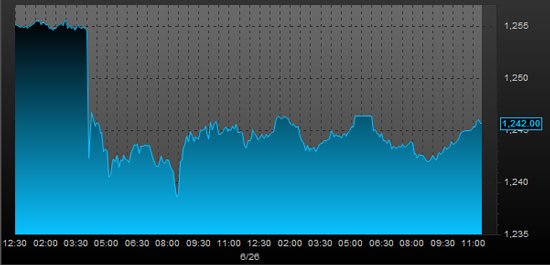
Then on Tuesday, June 27, the U.S. Dollar Index (DXY) dropped through the key support level at 97, which enticed users of other currencies to buy gold. The metal opened higher at $1,249 and steadied a little bit lower throughout the day to close at $1,247. That still marked a 0.2% gain from the previous close.
For reference, here's how the DXY has trended this past week...
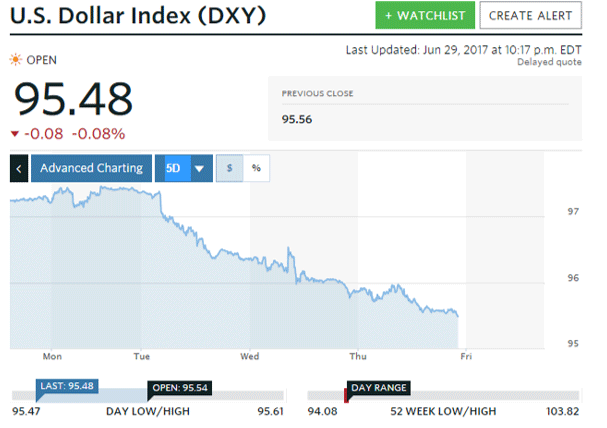
As the DXY continued to fall, gold benefited on Wednesday morning by opening at $1,252. But even the sustained drop in the DXY wasn't enough to support the gold price throughout the day. It fell back to $1,249 but still managed to gain 0.2% on the day.
On Thursday, June 29, the price of gold fell again on a minor DXY bounce that boosted the index to just under the 96 level. Gold opened lower at $1,242 but was able to edge a bit higher by the end of the session. It closed 0.3% lower at $1,245.
And the gold price today (Friday, June 30) is continuing yesterday's losses. It's down 0.3% and trading at $1,241. If it closes at that level, gold will post a weekly decline of 1.2%.
Looking over this past week, it's clear that the dollar's volatility has had the biggest effect on gold. That's why I want to take a closer look at the dollar's technical indicators - and how they could push gold prices to my bullish 2017 target.
Here's how high I see gold prices heading later this year...
My Bold Gold Price Prediction for the End of 2017
[mmpazkzone name="in-story" network="9794" site="307044" id="137008" type="4"]
If you check out the DXY over the last year, it's easy to see how 97 is the prime support level...
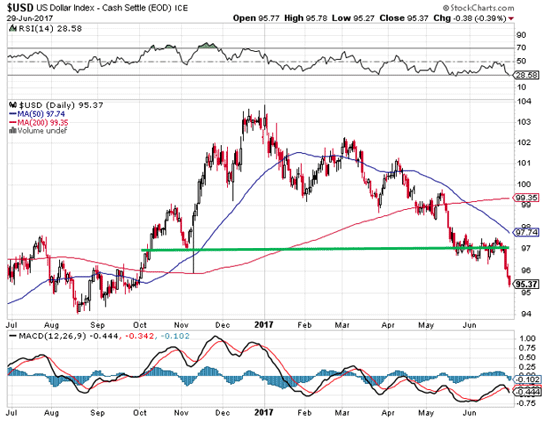
The Relative Strength Index (RSI) - a momentum indicator that measures the speed and change of an asset's price movements - suggests the dollar may be oversold right now. I wouldn't be surprised to at least see a dead cat bounce, perhaps to the 97 level, before the downtrend resumes.
And if we zoom out to a four-year chart, you can see that the DXY is quickly approaching the lower bound of its 93-103 trading range of the past two-and-a-half years...
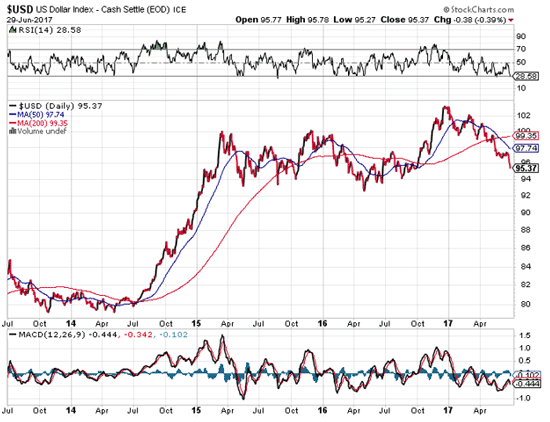
That looks like the point of no return. If the DXY breaks below 93 in a meaningful way, then the next stop may be 88, then 86, and then finally 80. And U.S. President Donald Trump would finally get his wish for a much weaker dollar, which I discussed in my April 17 silver column.
In that scenario, I'd expect to see gold absolutely soar over the long term, perhaps challenging its 2011 peak of $1,900. That would represent a stunning 53.1% gain.
Meanwhile, the lack of excitement in gold's price action may actually turn out to be a good thing...
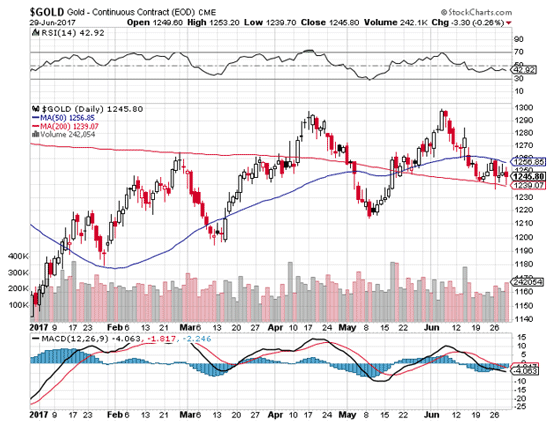
Although gold prices have come down once on June 20 to "test" the 200-day moving average of $1,239, the price of gold has so far managed to close above the 200-day moving average. That also bolsters the case for a possible new "lower high" being established, as the metal prepares for a new surge higher.
On that basis, I think the next target will be the 50-day moving average around $1,255, then $1,270 where we encounter some resistance, and then finally to $1,300. If that momentum continues, a $1,400 gold price by the end of Q4 2017 would look very attainable.
The Bottom Line: Gold's volatility over the last week has rattled investors looking for the metal to regain its previous June 6 high near $1,300. But the 1.2% loss this week is just a short-term reaction to wild swings in the dollar. I see the gold price rebounding 12.8% to $1,400 by the end of 2017 and 53.1% to $1,900 farther down the road as the DXY's technicals begin to support the metal.
Up Next: A door has opened for an ultra-rare but powerful anomaly in the stock market... It involves a precious metal, one that's considered exceedingly more rare than gold. Get all the details.


